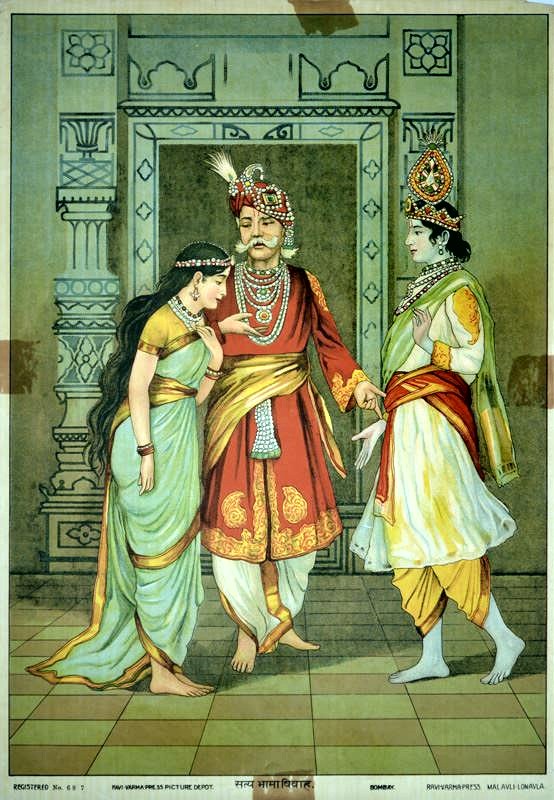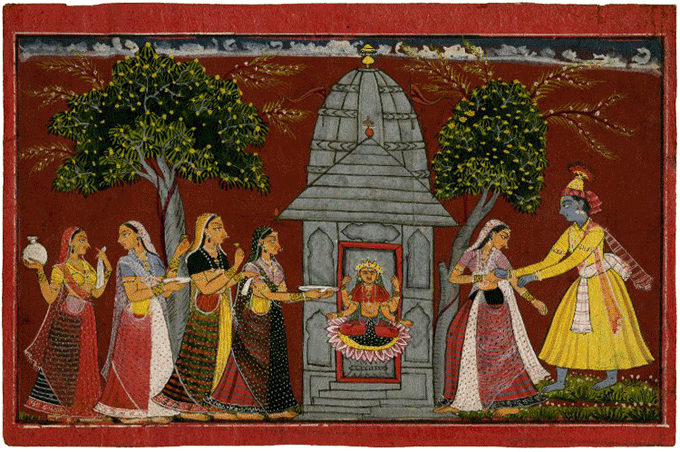|
Ashta Mathas Of Udupi
The Ashta Mathas of Udupi () are a group of eight ''mathas'' or Hindu monasteries established by Madhvacharya, the preceptor of the Dvaita school of Hindu thought with his direct disciples to be the first Swami, head of the matha. The Ashta Mathas are named after the villages in which they were originally located. Today, the mathas are situated in the temple town of Udupi. The mathas work to propagate the Dvaita philosophy. They also administer the Udupi Krishna Temple by way of a formal rotation scheme called ''Paryaya''. Each pair of mathas is called Dvandva (literally, ''two'' or ''dual''). The four pairs of mathas are: Palimaru and Adamaru; Krishnapura and Puttige; Shirur and Sodhe; and Kaniyooru and Pejavara. *Uttaradi Math *Mathatraya of Tattvavada *Madhva Mathas References *Around the Car Street External links Official ...
|
Madhvacharya
Madhvacharya (; ; 1199–1278 CE or 1238–1317 CE), also known as Purna Prajna () and Ānanda Tīrtha, was an Indian philosopher, theologian and the chief proponent of the ''Dvaita'' (dualism) school of Vedanta. Madhva called his philosophy ''Dvaita Vedanta, Tattvavāda'' meaning "arguments from a realist viewpoint". Madhvacharya was born at Pajaka near Udupi on the west coast of Karnataka state in 13th-century India. As a teenager, he became a Sannyasa, Sanyasi (monk) joining Brahma-sampradaya guru Achyutapreksha, of the Ekadandi order. Madhva studied the classics of Hindu philosophy, and wrote commentaries on the Principal Upanishads, the ''Bhagavad Gita'' and the Brahma Sutras (''Prasthanatrayi''), and is credited with thirty seven works in Sanskrit. His writing style was of extreme brevity and condensed expression. His greatest work is considered to be the ''Anuvyakhyana'', a philosophical supplement to his bhasya on the Brahma Sutras composed with a poetic structure. In ... [...More Info...] [...Related Items...] OR: [Wikipedia] [Google] [Baidu] |
Adamaru
Adamaru or Adamaar or Admar is a village in the Udupi district of the states and territories of India, state of Karnataka, India. The village houses one of the Udupi#The Ashta Mathas of Udupi, Ashta Mathas known as Adamaru Matha founded by Shri Madhvacharya, the Dvaita philosopher. The village can be reached by taking a left turn at Yermal near Kaup town on Udupi-Mangalore route on National Highway 66 (India), National Highway 66 while travelling from Mangalore to Udupi. There is pre-university ( junior) college at Adamaru run by Adamaru Matha Education Council. References External links *Poornaprajna Institute of Scientific Research Ashta Mathas of Udupi Villages in Udupi district {{Udupi-geo-stub ... [...More Info...] [...Related Items...] OR: [Wikipedia] [Google] [Baidu] |
Kaniyooru
Kaniyooru, also spelled Kaniyuru, is a village in Kadaba taluk in Dakshina Kannada district of Karnataka state, India. It houses one of the Ashta Mathas established by Madhvacharya, the Dvaita philosopher. The village is located on Mangalore to Bangalore broadguage railway line. There is a railway station at Kaniyooru. The railway station of Kaniyooru can be accessed by passenger trains running between Mangaluru and Subramanya road stations. The state highway 100 (SH-100) connecting Puttur to Kukke Subramanya passes through this village. There are frequent buses from Puttur to Kaniyooru to Kukke subhramanya. Kaniyoor Matha Shri Kaniyoor Matha or Kaniyur Mutt is one among the eight Mathas (which are popularly known as Ashta Matha) established by Shri Madhvacharya. Shri Rama Theertha, a direct disciple of Shri Madhvacharya, is the first pontiff of Kaniyoor Matha. Since then, there have been 29 pontiffs who have ably led Kaniyooru Matha and added to the glory of Matha. Shri Ra ... [...More Info...] [...Related Items...] OR: [Wikipedia] [Google] [Baidu] |
Sode Math Udupi
Sode may refer to: * Sode, Haute-Garonne, a commune in the Haute-Garonne department in France * Sode, Togo *The pauldron-analogue in Japanese armor. {{geodis ... [...More Info...] [...Related Items...] OR: [Wikipedia] [Google] [Baidu] |
Varaha
Varaha (, , "boar") is the avatar of the Hinduism, Hindu god Vishnu, in the form of a wild boar, boar. Varaha is generally listed as third in the Dashavatara, the ten principal avatars of Vishnu. In legend, when the demon Hiranyaksha steals the earth goddess Bhumi (goddess), Bhumi and hid her in the primordial waters, Vishnu appears as Varaha to rescue her. Varaha kills Hiranyaksha and retrieves the earth from the cosmic ocean, lifting her on his tusks, and restores her to her place in the universe. Varaha is depicted as a boar or in an anthropomorphic form, with a boar's head and the human body. Varaha often depicted lifing his consort Bhumi, the earth. Etymology and other names The deity Varaha derives its name from the Sanskrit word ''varaha'' (Devanagari: वराह, ) meaning "boar" or "wild boar". The word ''varāha'' is from Proto-Indo-Iranian language, Proto-Indo-Iranian term ''warāȷ́ʰá'', meaning boar. It is thus related to Avestan ''varāza'', Kurdish lan ... [...More Info...] [...Related Items...] OR: [Wikipedia] [Google] [Baidu] |
Vishnutirtha
Vishnu Tirtha (Subhaktiman) is a scholar of the Dvaita school of Vedanta philosophy and the founder of the monasteries at Sodhe and Subramanya. He left his home after his parents died to join the order of Brahma Sampradaya. He was initiated into the order by his older brother Madhvacharya Madhvacharya (; ; 1199–1278 CE or 1238–1317 CE), also known as Purna Prajna () and Ānanda Tīrtha, was an Indian philosopher, theologian and the chief proponent of the ''Dvaita'' (dualism) school of Vedanta. Madhva called his philosophy ... (1238–1317 CE), the founder of the Dvaita school. Subhaktiman was renamed Vishnu Tirtha after the initiation. He was succeeded by Aniruddha Tirtha at the Subramanya monastery. Sri Niketana Trust, Kukke Subramanya Matha. Retrieved 19 February 2013. He ... [...More Info...] [...Related Items...] OR: [Wikipedia] [Google] [Baidu] |
Sodhe
Sode is a village near Sirsi in the Uttara Kannada district of Karnataka in India. Location Sodhe is a village in the Malenadu region, surrounded by thick forests. It is 22 km from Sirsi and 13 km from Hulekal. Prehistoric rock art Prehistoric Rock art has been found near Sodhe. It comprises engravings and drawings dated to c. the first millennium BCE. In them, double sided squares with intersecting loops are engraved/ drawn. Such drawings have also been found at Hire Benakal, Gavali, Karnataka. They have some resemblance to present day rangoli/ rangavalli. History Sodhe or Sonda has a long, recorded history. Sonda kingdom was established in 1555 by Arasappa Nayaka, a Jain chieftain (1555–1598). Sonda was ruled by Sonda Nayakas for more than two hundred years (1555–1763). Arasappa Nayaka as vassal of Vijayanagara Dynasty till the fall of Vijayanagara to the Adil Shahis in 1565. He continued as the subordinate ruler of Adil Shah till his death in 1598 ... [...More Info...] [...Related Items...] OR: [Wikipedia] [Google] [Baidu] |
Sri Puthige Matha, Hindu Monastery
Shri (; , ) is a Sanskrit term denoting resplendence, wealth and prosperity, primarily used as an honorific. The word is widely used in South and Southeast Asian languages such as Assamese, Meitei ( Manipuri), Marathi, Malay (including Indonesian and Malaysian), Javanese, Balinese, Sundanese, Sinhalese, Thai, Tamil, Telugu, Odia, Assamese, Punjabi, Hindi, Bengali, Nepali, Malayalam, Kannada, Sanskrit, Pali, Khmer, and also among Philippine languages. It is usually transliterated as ''Sri'', ''Sree'', ''Shri'', ''Shiri'', ''Shree'', ''Si'', or ''Seri'' based on the local convention for transliteration. In Tamil it evolved to Tiru. The term is used in Indian subcontinent and Southeast Asia as a polite form of address equivalent to the English "Mr." in written and spoken language. "Shri" is also used as a title of veneration for deities or as honorific title for individuals. "Shri" is also an epithet for Hindu goddess Lakshmi, while a '' yantra'' or a mystica ... [...More Info...] [...Related Items...] OR: [Wikipedia] [Google] [Baidu] |
Satyabhama
Satyabhama (IAST'': Satyabhāmā)'' , also known as Satrajiti, is a Hindu goddess and the third queen consort of the Hindu god Krishna. Satyabhama is described as an incarnation of Bhumi, an aspect of Lakshmi. She is the goddess and the personification of the Earth. She has two sisters named Vratini and Prasvapini who are her co-wives as well. According to some traditions, she is regarded to have aided Krishna in defeating the asura Narakasura. Legend Marriage to Krishna Satyabhama was the daughter of Yadava King Satrajita, the royal treasurer of Dvaraka, who was the owner of the Syamantaka jewel. Satrajita, who secured the jewel from the sun-god Surya and would not part with it even when Krishna, the king of Dvaraka, asked for it saying it would be safe with him. Shortly thereafter, Prasena, the brother of Satrajita, went out hunting wearing the jewel but was killed by a lion. Jambavan, known for his role in the Ramayana, killed the lion and gave the jewel to his ... [...More Info...] [...Related Items...] OR: [Wikipedia] [Google] [Baidu] |
Rukmini
Rukmini (, ) is a Devi, Hindu goddess and the first queen of Krishna. She is described as the chief of Krishna's wives in Dvārakā. Rukmini is revered as the avatar of Lakshmi and is venerated primarily in Warkari, and Haridasa tradition, and additionally in Sri Vaishnavism. Rukmini is mainly worshipped in Maharashtra and South India. The people of Maharashtra venerate her with Vithoba (a regional form of Krishna) and call her Rakhumai. In South India, she is worshipped along with Krishna and his and his other primary consort Satyabhama. Her birthday is celebrated every year on the occasion of Rukmini Ashtami. Etymology and epithets The name ''Rukmini'' is derived from the Sanskrit word ''Rukma'' which means 'radiant', 'clear' or 'bright'. The name can also mean 'decorated with gold ornaments'. Other names and epithets include: *''Shri'' – Lakshmi *''Vaidarbhi'' – She who is from the kingdom of Vidarbha *''Bhaishmi'' – Daughter of Bhishmaka *''Rakhumai'' – Mother Rukm ... [...More Info...] [...Related Items...] OR: [Wikipedia] [Google] [Baidu] |
Puttige Matha
Puthige Matha (Kannada: ಪುತ್ತಿಗೆ ಮಠ) or Puttige Mutt in some records and literature is a Madhwa Vaishnava monastery. It is one of the Ashta Mathas of Udupi founded by Dvaita philosopher Madhvacharya of Udupi. The first pontiff of Puttige matha was Sri Upendra Tirtha, who was a direct disciple of Sri Madhvacharya, the founder of the Dvaita school of philosophy. The main idols worshipped in the Puttige matha are that of Panduranga (Vittala), which was given to Sri Upendra Tirtha by Sri Madhvacharya. Till date, there have been 29 pontiffs who have headed the matha. The current Swamiji of the matha is Shri Sugunendra Tirtha Swamiji The Lineage of Swamiji's (guru parampara) # Upendra Tirtha- Sri Madhwavijaya mentions a story of Sri Upendra teeertha. Sri Madhva undertook a second trip to Badari. On the way, many interesting incidents took place. Once, after Sri Madhva and his followers crossed the Ganga river, the troops of a Muslim ruler arrested all ... [...More Info...] [...Related Items...] OR: [Wikipedia] [Google] [Baidu] |



